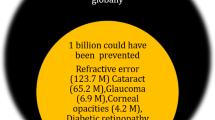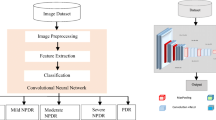Abstract
Purpose
Diabetic retinopathy (DR) is non-recoverable in nature. One of the advanced sight threatening condition in diabetic patient is defined in terms of diabetic macular edema (DME), where the macula gets deposited with fluid rich in proteins called exudates. It is indisputably required to find and treat occurrence of exudates near macula in time, to avoid further complications of retina and vision loss at later stage. However, presence of various dark and bright lesions awakes the need of reliable macula and exudate detection process. Proposed work intends to present a robust, scale, and rotation invariant tool for early diagnosis of DME.
Methods
Optic disc (OD) diameter is one of the important parameters; it is always proportional to the size of the retina; an adaptive method based on pixel count and histogram-based segmentation is used for optic disc detection. Center of macula is detected based on estimated optic disc radius calculations and anatomical priors. In order to reduce computational burden, two disc diameter (DD) region near macula is extracted. Hard exudates are extracted with unique combination of CLAHE and morphological operations, followed by Kirsch’s mask for sharp edge detection of hard exudates, and further morphological operations for noise removal.
Results
OD detection algorithm is evaluated on four different databases DiaretDB1, MESSIDOR, DRIONS-DB, and images from local hospital, overall sensitivity of 95.71% is achieved, highest sensitivity value is 98%, and is achieved on first 100 images from MESSIDOR database. Further DiaretDB1 and images from local hospital are processed further for macula detection and exudates finding in macular proximity, as DiaretDB1 is rich in variety of DR lesions and images from the local hospital to deal with real-time issues. Finding macula region is achieved with an overall success rate of 91.93% and overall sensitivity of 99% is reported on both the chosen databases.
Conclusion
Proposed work provides an automated tool, for early diagnosis of diabetic macular edema. The method is straightforward, robust and computationally less complex and improved success rates for feature, and lesion detections are achieved as compared with state-of-the-art methods.







Similar content being viewed by others
References
Abdel-Ghafar AD, Morris T. Progress towards automated detection and characterization of the optic disc in glaucoma and diabetic retinopathy. Med Inform Internet Med. 2007;32(1):19-25. https://doi.org/10.1080/14639230601095865.
Agurto C, Murray V, Yu H, Wigdahl J, Pattichis M, Nemeth S, et al. A multiscale optimization approach to detect exudates in the macula. IEEE Biomed Health Inf. 2014;18:1328-37.
Akram MU, Tariq A, Khan SA, Javed MY. Automated detection of exudates and macula for grading of diabetic macular edema. Comput Methods Prog Biomed. 2014;114:141-52.
Allam AMN, Yussif AA, Ghalwash AZ. Optic disc segmentation by weighting the vessel density within the strongest candidates. London: SAI Computing Conference; 2016. p. 91-9.
Aquino A, Gegúndez-Arias ME, Marín D. Detecting the optic disc boundary in digital fundus images using morphological, edge detection, and feature extraction techniques. IEEE Trans Med Imag. 2010;29(11):1860-9. https://doi.org/10.1109/TMI.2010.2053042.
Ashame LA, Youssef SM, Fayed SF. Abnormality detection eye fundus retina, Int.Conf. on Computer and Applications, 978-1-5386-4371-6/18/@31.00©2018 IEEE,pp.285-290. 2018.
Badsha S, Reza AW, Tan KG, Dimyati K. A new blood vessel extraction technique using edge enhancement and object classification. J Digit Imaging. 2013;26(6):1107-15. Published online 2013 Mar 21. https://doi.org/10.1007/s10278-013-9585-8.
Bansal A, Vats A, Jain A, Dutta MK. An efficient automatic intensity based bethod for detection of macula in retinal images. IEEE 2016,PP- 507-510.
Cardenas JM, Martinez-Perez ME, March F, Hevia-Montiel N. Mean shift based automatic detection of exudates in retinal images. Image Process Communications Challenges 4Springer AISC. 2013;184:73-82.
Carmona EJ, Rincon M, Garcia-Feijoo J, Martinez-de-la-Casa JM. Identification of the optic nerve head with genetic algorithms. Artificial Intell Med. 2008;43(3):243-59. https://doi.org/10.1016/j.artmed.2008.04.005.
Chrástek R, Wolf M, Donath K, Michelson G, Niemann. Optic disc segmentation in retinal images. In: Bildverarbeitung für die Medizin, vol. 2002: Springer Berlin Heidelberg; 2002. p. 263-6. https://doi.org/10.1007/978-3-642-55983-9_60.
Dehghani A, Moghaddam HA, Moin M. Optic disc localization in retinal images using histogram matching. EURASIP J Image Video Process. 2012:1-11.
Dutta MK, Ganguly S., Srivastava K. An efficient grading algorithm for non-proliferative diabetic retinopathy using region based detection. TSP 2015,IEEE. 2015, PP- 743-747.
Ege BM, Hejlese L, Larsen OV, Moller B, Kerr M. Screening for diabetic retinopathy using computer-based image analysis and statistical classification. Computer Methods Programs Biomed. 2000:165-75. https://doi.org/10.1016/S0169-2607(00)00065-1.
Fleming AD, Goatman KA, Philip S, Olson JA, Sharp PF. Automatic detection of retinal anatomy to assist diabetic retinopathy screening. Phys Med Biol. January 2007;52(2):331-45.
Foracchia M, Grisan E, Ruggeri A. Detection of optic disc in retinal images by means of a geometrical model of vessel structure. IEEE Trans. Med. Imag. October 2004;23(10):1189-95. https://doi.org/10.1109/TMI.2004.829331.
Gagnon L, Lalonde M, Beaulieu M, Boucher MC. Procedure to detect anatomical structures in optical fundus images, SPIE Med. Imaging: Image Process. 2001:1218-25. https://doi.org/10.1117/12.430999.
Ganguly S, Srivastava K, Ganguly S. An efficient grading algorithm for non-proliferative diabetic retinopathy using region based detection. 37th International Conference on Telecommunications and Signal Processing (TSP- 2014). Berlin; 2014. p. 503-7.
Garcia M, Sanchez CI, Hornero R. Detection of hard exudates in retinal images using a radial basis function classifier, Annual of Biomedical Engineering, Springer,2009a, pp. 1448-1463.
Garcia M, Sanchez CI, Lopez MI, Abasolo D, Hornero R. Neural network based detection of hard exudates in retinal images. Comput Methods Prog Biomed. 2009b;93:9-19.
Godse, Dr. Bormane DS. Automated localization of optic disc in retinal images. Int J Adv Comput Sci Appl, (IJACSA).2013; Vol. 4, No. 2.
Goldbaum M, Moezzi S, Taylor A, Chatterjee S, Boyd J, Hunter E, Jain R. Automated diagnosis and image understanding with object extraction, object classification, and inferencing in retinal images. in Proc. IEEE Int. Congr. Image Process., 1996.
Grisan E, Ruggeri A. A markov random field approach to outline lesions in fundus images” ECIFMBE, IFMBE Proceedings 22. 2008. 472-475 Springer.
Harangi B, Hajdu A. Automatic exudate detection by using multiple active contours and region wise classification. Comput Biol Med. 2014;54:156-71. https://doi.org/10.1016/j.compbiomed.2014.09.001.
Hoover A, Goldbaum M. Locating the optic nerve in a retinal image using the fuzzy convergence of the blood vessels. IEEE Trans Med Imag. 2003;22(8):951-8. https://doi.org/10.1109/TMI.2003.815900.
Hsu W, Pallawala PMDS, Lee ML, Eong KGA. The role of domain knowledge in the detection of retinal hard exudates, IEEE CVPR. 2001, pp. 246-251.
Hunter A, Lowell L, Owens K, Quantification of diabetic retinopathy using neural networks and sensitivity analysis, Proc. Artificial Neural Network Med. Biol. Springer, 2000, pp. 81-86.
Imani E, Pourreza HR. A novel method for retinal exudate segmentation using signal separation algorithm, Elsevier North-Holland, Inc, 2016.
Jelinek HF, Cree MJ. Automated Image Detection of Retinal Pathology: Taylor & Francis Group CRC Press; 2010.
Kansky J. Clinical ophthalmology. London: Butterworth-Heinmann; 1994.
Kauppi T. Eye Fundus Image Analysis for Automatic Detection of Diabetic Retinopathy. Lappeenranta: PhD Thesis; 2010.
Kauppi T, et al. DIARETDB1 diabetic retinopathy database and evaluation protocol. Proc Br Mach Vis Conf. 2007;1:15. 1-10.
Kayal, D and Banerjee, S. A new dynamic thresholding based technique for detection of hard exudates in digital retinal fundus image, International Conf. on Signal Processing and Integrated Networks,Spin,pp.141-144, 2014.
Kochner Z, Ugi H. Hybrid fuzzy image processing for situation assessment: a knowledge based system for early detection of diabetic retinopathy. IEEE Eng Med Biol Mag. 2000:76-83.
Kumar TA, Priya S, Paul V. A novel approach to the detection of macula in human retinal imagery. Int J Signal Process Syst. June 2013;1(1):23-8.
Kusakunniran W, Wu Q, Ritthipravat P, Zhang J. Hard exudates segmentation based on learned initial seeds and iterative graph cut. Comput Methods Prog Biomed. 2018;158:173-83.
Lalonde M, Beaulieu M, Gagnon L. Fast and robust optic disc detection using pyramidal decomposition and Hausdorff-based template matching. IEEE Trans Med Imag. 2001;20(11):1193-200. https://doi.org/10.1109/42.963823.
Lee SS, Rajeswari M, Ramachandram D. Preliminary and multi features localisation of optic disc in colour fundus images., National Computer Science ostgraduate Colloquium, Malaysia. 2005.
Li H, Chutatape O. Automated feature extraction in color retinal images by a model based approach. IEEE Trans Biomed Eng. February 2004;51(2):246-54. https://doi.org/10.1109/TBME.2003.820400.
Liang Z, Wong DWK, Liu J, Tan NM, Cheng X, Cheung GCM, Bhargava M, Wong TY.Automatic fovea detection in retinal fundus images. 7th IEEE Conference on Industrial Electronics and Applications (ICIEA), 2012, pp. 1746-1750.
Liu Q, Zou B, Chen J, Ke W, Yue K, Chen Z, et al. A location-to-segmentation strategy for automatic exudate segmentation in colour retinal fundus images. Comput Med Imaging Graph. 2017;55:78-86.
Long S, Huang X, Chen Z. Automatic detection of hard exudates in color retinal images using dynamic threshold and SVM classification: algorithm development and evaluation, Hindawi BioMed Research International. 2019,Article ID 3926930.
Lowell J, Hunter A, Steel D, Ryder B, Fletcher E. Optic nerve head segmentation. IEEE Trans Med Imag. 2004;II(23). https://doi.org/10.1109/TMI.2003.823261.
Lu S. Accurate and efficient optic disc detection and segmentation by a circular transformation. IEEE Trans. Med. Imag. 2011;30(12):2126-33. https://doi.org/10.1109/TMI.2011.2164261.
Lu S, Lim JH. Automated macula detection from retinal images by a line operator., IEEE 17th International Conference on Image Processing. 2010, pp. 4073-4076.
Mitra SK, Lee TW, Goldbaum M. Bayesian network based sequential inference for diagnosis of diseases from retinal images. Pattern Recognit Lett. 2005;459:-470. https://doi.org/10.1016/j.patrec.2004.08.010.
Niemeijer M, Abramoff MD, van Ginneken B. Fast detection of the optic disc and fovea in color fundus photographs. Med Image Anal. December 2009;13(6):859-70. https://doi.org/10.1016/j.media.2009.08.003.
Nyni KA, Drisya MK, Thomas NR. Detection of macula in retinal images using morphology. Int J Adv Res Comput Sci Softw Eng. 2014;4(1):908-11.
Osareh A, Majid M, Thomas B, Markham R. Comparative exudate classification using support vector machines and neural networks, Med. Image Comp. Comp.- Assisted Intervention. 2002, 413-420.
Osareh A, Mirmehdi M, Thomas B, Markham R. Automated identification of diabetic retinal exudates in digital color images. Br J Ophthalmol. 2003;87:1220-3. https://doi.org/10.1136/bjo.87.10.1220.
Park M, Jin JS, Luo S. Locating the optic disc in retinal images. in Proc. 3rd Int. Conf. Computer Graphics, Imaging Visualization, Sydney, Australia, 2006. DOI: https://doi.org/10.1109/CGIV.2006.63
Park J, Kien NT, Lee G. Optic disc detection in retinal images using tensor voting and adaptive mean-shift, in 2007 IEEE Int Conf Intell Comput Commun Process. 2007. DOI: https://doi.org/10.1109/ICCP.2007.4352167.
Ram K, Sivaswamy J. “Multi-space clustering for segmentation of exudates in retinal color photographs,” in Proceedings of the Annual International Conference of the IEEE Engineering in Medicine and Biology Society. Minneapolis; 2009. p. 1437-40.
Rangayyan RM, Zhu X, Ayres FJ, Ells AL. Detection of the optic nerve head in fundus images of the retina with Gabor filters and phase portrait analysis. J. Digital Imaging. August 2010;23(4):438-53. https://doi.org/10.1007/s10278-009-9261-1.
Reza AH, Eswaran E. Diagnosis of diabetic retinopathy: automatic extraction of optic disc and exudates from retinal images using marker-controlled watershed transformation: Springer Science + Business Media, LLC; 2010. p. 1491-501.
Roychowdhury S, Koozekanani DD, Parhi KK. DREAM: diabetic retinopathy analysis using machine learning. IEEE J Biomed Health Inf. 2014;18:1717-29.
Sinthanayothin C. Image analysis for automatic diagnosis of diabetic retinopathy: PhD Thesis, King’s College London; 1999.
Sinthanayothin C, Boyce JF, Cook HL, Williamson TH. Automated localisation of the optic disc, fovea, and retinal blood vessels from digital colour fundus images. Br J Ophthalmol. 1999;4(83):902-10. https://doi.org/10.1136/bjo.83.8.902.
Soares I, Castelo-Branco M, Pinheiro AMG.“Exudates dynamic detection in retinal fundus images based on the noise map distribution,” in Proceedings of the 19th IEEE European Signal Processing Conference (EUSIPCO ‘11), pp. 46-50, Barcelona, Spain, 2011.
Tan NM, Wong DWK, Liu J, Ng WJ, Zhang Z, Lim JH, Tan Z, Tang Y, Li H, Lu S, Wong TY.Automatic detection of the macula in the retinal fundus image by detecting regions with low pixel intensity. 2009 International Conference on Biomedical and Pharmaceutical Engineering. 2009, pp. 1-5.
ter Haar F. Automatic localization of the optic disc in digital colour images of the human retina. 2005.
Thirasamma J, Jacob D, Singh N. Detection of hard exudates in colour fundus images using fuzzy support vector machine-based expert system. J Digit Imaging. 2015;28:28-768. https://doi.org/10.1007/s10278-015-9793-5.
Walter T, Klein J. Segmentation of color fundus images of the human retina: detection of the optic disc and the vascular tree using morphological techniques. in Proc. 2nd Int. Symp. Medical Data Analysis (ISMDA '01), 2001. DOI: https://doi.org/10.1007/3-540-45497-7_43
Walter T, Klein JC, Massin P, Erginay A. Contribution of image processing to the diagnosis of diabetic retinopathy detection of exudates in color fundus images of the human retina. IEEE Trans Med Image. 2002;21:1236-43.
Ward NP, Tomlinson S, Taylor CJ. The detection and measurement of exudates associated with diabetic retinopathy. Ophthalmology. 1989;96:80-6. https://doi.org/10.1016/S0161-6420(89)32925-3.
Win KY, Choomchuay S. Automated detection of exudates using histogram analysis for digital retinal images, International Symposium on Intelligent Signal Processing and Communication Systems, (2016), pp. 25–29.
Wong TY, Klein R, Sharrett AR, Schmidt MI, Pankow JS, Couper DJ, et al. Retinal arteriolar narrowing and risk of diabetes mellitus in middle-aged persons. J Am Med Assoc. 2002;287(19):2528-33.
Wong DWK, Liu J, Tan NM, Yin F, Cheng X, Cheng CY, et al. “Automatic detection of the macula in retinal fundus images using seeded mode tracking approach” 34th Annual International Conference of the IEEE EMBS. San Diego; 2012. p. 4950-3.
Xiao Z, Li F, Geng L, Zhang F, Wu J, Zhang X, Su L, Shan C. Hard Exudates Detection Method Based on Background-Estimation, Springer ICIG, 2015, pp. 361-372.
Xu L, Luo S. Support vector machine based method for identifying hard exudate in retinal images, Information, Computing and Telecommunication, YC-ICT IEEE, Youth Conference, 2009, pp. 138-142.
Youssif AAA, Ghalwash AZ, Ghoneim AASA. Optic disc detection from normalized digital fundus images by means of a Vessels’ direction matched filter. IEEE Trans Med Imag. 2008;27(1):11-8. https://doi.org/10.1109/TMI.2007.900326.
Yu CY, Yu S-S. Automatic localization of the optic disc based on iterative brightest pixels extraction. in 2014 Int. Symp. Comput. Consumer Control, 2014. DOI: https://doi.org/10.1109/IS3C.2014.166.
Zhang B, Karray F. Optic disc detection by multi-scale Gaussian filtering and with scale production and vessels directional match filter, medical biometrics: second international conference, ICMB 2010, Hong Kong, 2010, pp. 173-180
Zhang D, Zhao Y. Novel accurate and fast optic disc detection in retinal images with vessel distribution and directional characteristics. IEEE J. Biomed. Health Informatics. 2014;99. https://doi.org/10.1109/JBHI.2014.2365514.
Zheng S, Pan L, Chen J, Yu L. Automatic and efficient detection of the fovea center in retinal images. BMEI. 2014, p.p. 145-150.
Zhu X, Rangayyan RM, Ells AL. Detection of the optic nerve head in fundus images of the retina using the Hough transform for circles. J Digital Imaging. 2010;23(3):332-41. https://doi.org/10.1007/s10278-009-9189-5.
Zuiderveld K. Contrast limited adaptive histogram equalization. In: Heckbert P, editor. Graphics gems (IV). Boston; 1994.
Acknowledgments
The authors wish to thank ophthalmologist Dr. Sharad Bhomaj from the Shanti Saroj Netralay, Miraj, India, for kindly providing us with retinal landmarks, lesion ground truth, and clinical advice.
Author information
Authors and Affiliations
Corresponding author
Ethics declarations
Conflict of interest
The authors declare that they have no conflict of interest.
Additional information
Publisher’s note
Springer Nature remains neutral with regard to jurisdictional claims in published maps and institutional affiliations.
Rights and permissions
About this article
Cite this article
Patil, S.B., Patil, B.P. Automated macula proximity diagnosis for early finding of diabetic macular edema. Res. Biomed. Eng. 36, 249–265 (2020). https://doi.org/10.1007/s42600-020-00065-9
Received:
Accepted:
Published:
Issue Date:
DOI: https://doi.org/10.1007/s42600-020-00065-9




